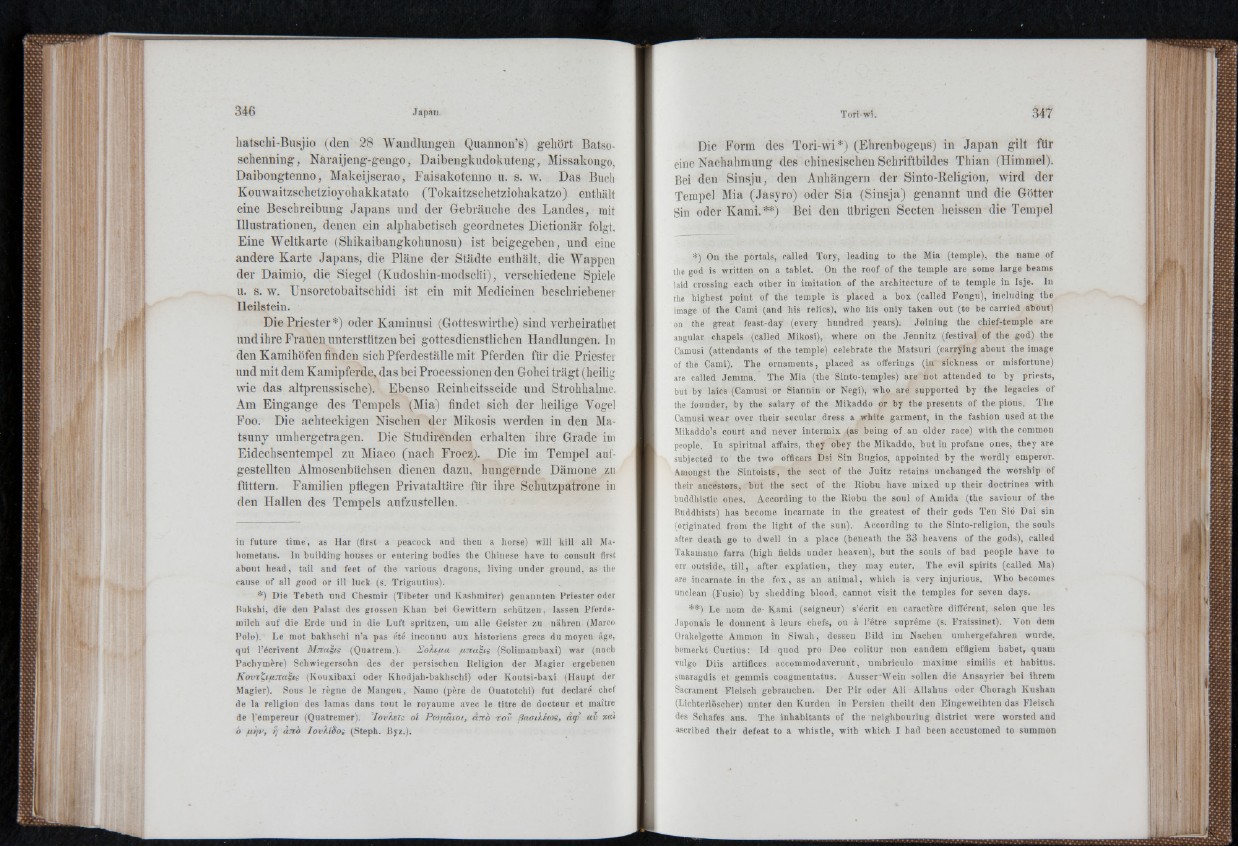
hatschi-Busjio (den 28 Wandlungen Quannon’s) gehört Batso-
schenning, Naraijeng-gengo, Daibengkudokuteng, Missakongo,
Daibongtenno, Makeijserao, Faisakotenno u. s. w. Das Buch
Kouwaitzschetzioyokakkatato (Tokaitzschetziohakatzo) enthält
eine Beschreibung Japans und der Gebräuche des Landes, mit
Illustrationen, denen ein alphabetisch geordnetes Dictionär folgt.
Eine Weltkarte (Shikaibangkohunosu) ist beigegeben, und eine
andere Karte Japans, die Pläne der Städte enthält, die Wappen
der Daimio, die Siegel (Kudoshin-modsclii), verschiedene Spiele
u. s. w. Unsoretobaitschidi ist ein mit Medicinen beschriebener
Heilstein.
Die Priester*) oder Kaminusi (Gotteswirthe) sind verheirathet
und ihre F rauen unterstützen bei gottesdienstlichen Handlungen. In
den Kamihöfen finden sich Pferdeställe mit Pferden für die Priester
und mit dem Kamipferde, das bei Processionen den Gohei trägt (heilig
wie das altpreussische). Ebenso Reinheitsseide und Strohhalme.
Am Eingänge des Tempels (Mia) findet sich der heilige Vogel
Foo. Die achteckigen Nischen der Mikosis werden in den Ma-
tsuny umhergetragen. Die Studirenden erhalten ihre Grade im
Eidechsentempel zu Miaco (nach Froez). Die im Tempel aufgestellten
Almosenbuchsen dienen dazu, hungernde Dämone zu
füttern. Familien pflegen Privataltäre für ihre Schutzpatrone in
den Hallen des Tempels aufzustellen.
in future time, as Har (first a peacock and then a horse) will kill all Mahometans.
In building houses or entering bodies the Chinese have to consult first
about head, tail and feet of the various dragons, living under ground, as the
cause of all good or ill luck (s. Trigautius).
*) Die Tebeth und Chesmir (Tibeter und KaShmirer) genannten Priester oder
Bakshi, die den Palast des giossen Khan bei Gewittern schützen, lassen Pferdemilch
auf die Erde und in die Luft spritzen, um alle Geister zu nähren (Marco
Polo). Le mot bakhschi n’a pas été inconnu aux historiens grecs du moyen âge,
qui l ’écrivent MfitaiiM (Quatrem.). SoXifia fm&jgis (Solimambaxi) war (nach
P achy mère) Schwiegersohn des der persischen Religion der Magier ergebenen
KovrÇi/LCTtaÇis (Kouxibaxi oder Khodjah-bakhschi) oder Koutsi-baxi (Haupt der
Magier). Sous le règne de Mangou, Namo (père de Ouatotchi) fut déclaré chef
de la religion des lamas dans tout le royaume avec le titre de docteur et maître
de l’empereur (Quatremer). 'lovXels ol Ptxtfmioi, cctto r o v ßaoiXscos, à y a v xctt
o pit]v, f] àno IovXidoi (Steph. Byz.).
Die Form des Tori-wi*) (Ehrenbogens) in Jap an gilt für
eine Nachahmung des chinesischen Schriftbildes Thian (Himmel).
Bei den Sinsju, den Anhängern der Sinto-Religion, wird der
Tempel Mia (Jasyro) oder Sia (Sinsja) genannt und die Götter
Sin oder Kami.**) Bei den übrigen Secten heissen die Tempel
*) On the portals, called Tory, leading to the Mia (temple), the name of
the god is written on a tablet. On the roof of the temple are some large beams
laid crossing each other in imitation of the architecture of te temple in Isje. In
the highest point of the temple is placed a box (called Fongu), including the
image of the Cami (and his relics), who his only taken out (to be carried about)
on the great feast-day (every hundred years). Joining the chief-temple are
angular chapels (called Mikosi), where on the Jennitz (festival of the god) the
Camusi (attendants of the temple) celebrate the Matsuri (carrying about the image
of the Cami). The ornaments, placed as offerings (in sickness or misfortune)
are called Jemma. The Mia (the Sinto-temples) are not attended to by priests,
but by laics (Camusi or Siannin or Negi), who are supported by the legacies of
the founder, by the salary of the Mikaddo or by the presents of the pious. The
Camusi wear over their secular dress a white garment, in the fashion used at the
Mikaddo’s court and never intermix (as being of an older race) with the common
people. In spiritual affairs, they obey the Mikaddo, b u tin profane ones, they are
subjected to the two officers Dsi Sin Bngios, appointed by the wordly emperor.
Amongst the Sintoists, the sect of the Juitz retains unchanged the worship of
their ancestors, but the sect of the Riobu have mixed up their doctrines with
buddhistic ones. According to the Riobu the soul of Amida (the saviour of the
Buddhists) has become incarnate in the greatest of their gods Ten Sid Dai sin
(originated from the light of the sun). According to the Sinto-religion, the souls
after death go to dwell in a place (beneath the 33 heavens of the gods), called
Takamano farra (high fields under heaven), but the souls of bad people have to
err outside, t ill, after expiation, they may enter. The evil spirits (called Ma)
are incarnate in the fo x , as an animal, which is very injurious. Who becomes
unclean (Fusio) by shedding blood, cannot visit the temples for seven days.
**) Le nom de- Kami (seigneur) s’écrit en caractère différent, selon que les
Japonais le donnent à leurs chefs, ou à l’être suprême (s. Fraissinet). Von dem
Orakelgotte Ammon in Siwah, dessen Bild im Nachen umhergefahren wurde.,
bemerkt Curtius: Id quod pro Deo colitur non eandem effigiem habet, quam
vulgo Diis artifices accommodaverunt, umbriculo maxime similis et habitus,
smaragdis et gemmis coagmentatus. Ausser'Wein sollen die Ansayrier bei ihrem
Sacrament Fleisch gebrauchen. Der Pir oder Ali Allahus oder Choragh Kushan
(Lichterlöscher) nnter den Kurden in Persien theilt den Eingeweihten das Fleisch
des Schafes aus. The inhabitants of the neighbouring district were worsted and
ascribed their defeat to a whistle, with which I had been accustomed to summon